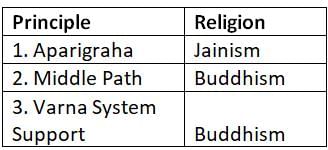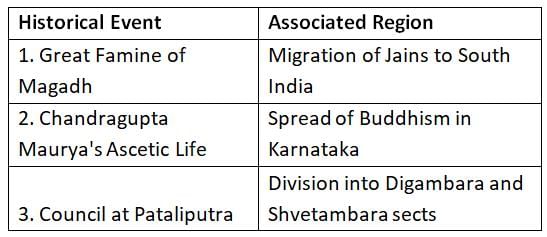Test: Buddhism & Jainism - UPSC MCQ
20 Questions MCQ Test - Test: Buddhism & Jainism
Consider the following statements about Jainism:
- Jainism advocates for a strict adherence to non-violence (Ahimsa) as its core principle.
- Mahavira, the 24th Tirthankara of Jainism, introduced the practice of discarding clothes, leading to the division between Digambara and Shvetambara sects.
- Jainism played a significant role in the spread of the Varna system in ancient India.
How many of the statements given above are correct?
What are the two major ancient sub-traditions under Jainism?
Consider the following statements:
1. Digambara monks do not wear clothes as this sect believes in complete nudity.
2. Svetambara monks follow only 4 constraints (Ahimsa, Satya, Asteya, Aparigraha, and not Brahmacharya) as per the teachings of Mahavira.
3. Bhadrabahu, an exponent of Digambara, moved to Karnataka along with his disciples after predicting a long famine.
Which of the statements given above is/are correct?
What was the original name of Siddhartha, who later became known as Buddha?
Consider the following statements regarding Mahayana Buddhism:
1. Mahayana Buddhism believes in idol or image worship.
2. Emperor Kanishka of the Kushana dynasty is considered the founder of the Mahayana sect in the 1st century AD.
3. The scholars of Mahayana Buddhism predominantly used the Pali language.
Which of the statements given above is/are correct?
Consider the following pairs:

How many of the above pairs are correctly matched?
Consider the following statements regarding Vajrayana Buddhism:
1. Vajrayana Buddhism is primarily based on the principles of Theravada Buddhism.
2. It incorporates the use of Tantras, Mantras, and Yantras in its practices.
3. Vajrayana Buddhism identifies Tara as a significant deity.
Which of the statements given above is/are correct?
Consider the following statements:
Statement-I:
Monks of the Digambara School do not wear clothes as they believe in complete nudity.
Statement-II:
Monks of the Svetambara School believe in wearing simple white clothing along with other items like a begging bowl, a brush, books, and writing materials.
Which one of the following is correct in respect of the above statements?
What is a key belief that distinguishes Mahayana Buddhism from Hinayana Buddhism?
Consider the following statements:
Statement-I:
Buddhism originated from the story of Siddhartha (Buddha) in the Indian subcontinent.
Statement-II:
Buddhism is the world's fourth-largest religion after Christianity, Islam, and Hinduism.
Which one of the following is correct in respect of the above statements?
Consider the following statements about the causes of the spread of Jainism:
- Chandragupta Maurya's conversion to Jainism played a crucial role in spreading Jainism to South India.
- The great famine in Magadh around 260 BC led to the migration of Jains to the South, significantly influencing the spread of Jainism.
- Jainism's support for the Varna system facilitated its rapid spread across different social classes in ancient India.
How many of the statements given above are correct?
Vajrayana Buddhism, also called Tantric Buddhism, drew significant influence from which religious tradition?
Statement-I: Buddhism's principle of non-violence (Ahimsa) led to its adoption by agricultural and trading communities, which found the teachings conducive to their economic activities and social practices.
Statement-II: The emphasis on non-violence in Buddhism directly contributed to a reduction in warfare and conflicts, promoting a more stable and prosperous society conducive to trade and agriculture.
Which one of the following is correct in respect of the above statements?
Consider the following pairs:

How many of the above pairs are correctly matched?
Consider the following statements regarding Buddhism:
1. Siddhartha Gautama attained enlightenment under a pipal tree in Bodh Gaya.
2. The first sermon of Buddha after attaining Nirvana was at Deer Park in Sarnath.
3. The three major pitakas of Buddhism are written in Sanskrit.
Which of the statements given above is/are correct?
Consider the following statements regarding the teachings of Mahavira:
- Mahavira attained enlightenment at the age of 42 and became known as the 'Jina', marking the foundation of Jainism.
- One of the key teachings of Mahavira was the strict adherence to the caste system to maintain social order.
- Mahavira emphasized the concept of 'Aparigraha', advocating for minimalism and detachment from material possessions.
How many of the statements given above are correct?
Consider the following pairs:

How many of the above pairs are correctly matched?
Consider the following statements:
Statement-I:
Vajrayana Buddhism combines Veda-based rituals with Buddhist philosophies.
Statement-II:
Navayana Buddhism rejects monk & monasticism, karma, rebirth in the afterlife, samsara, meditation, enlightenment & Four Noble Truths.
Which one of the following is correct in respect of the above statements?
Consider the following statements
Statement-I: Jainism's teachings on non-violence (Ahimsa) led to the creation of specialized communities focused on animal welfare and environmental conservation.
Statement-II: The principle of Ahimsa in Jainism emphasizes harmlessness towards all living beings, influencing both individual behavior and community practices.
Which one of the following is correct in respect of the above statements?
Consider the following statements:
Statement I:
Hinayana Buddhism does not believe in idol or image worship of Buddha but believes in individual salvation through self-discipline and meditation.
Statement II:
Mahayana Buddhism believes in idol or image worship and emphasizes the heavenliness of Buddha and Bodhisattvas embodying Buddha Nature.
Which one of the following is correct in respect of the above statements?














